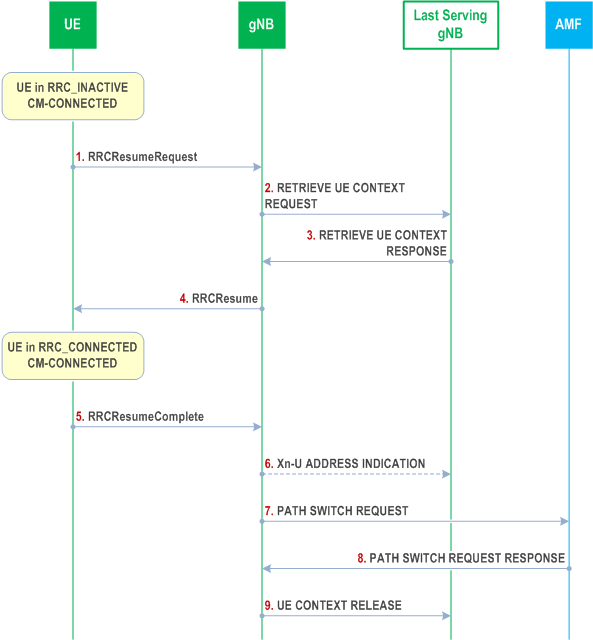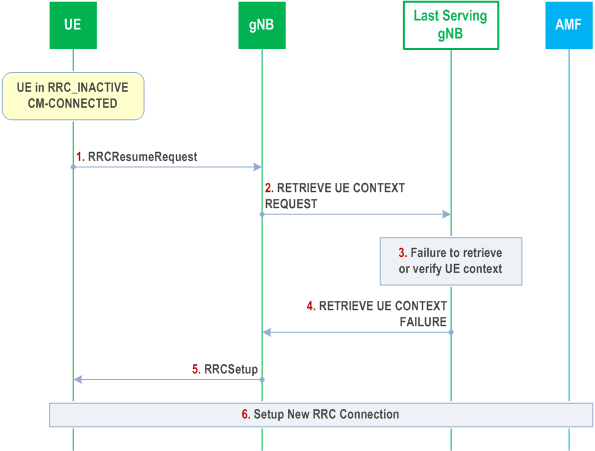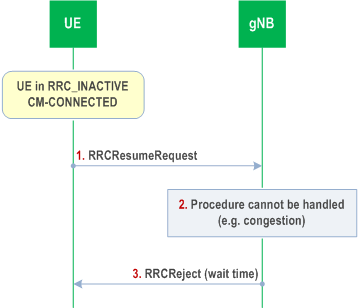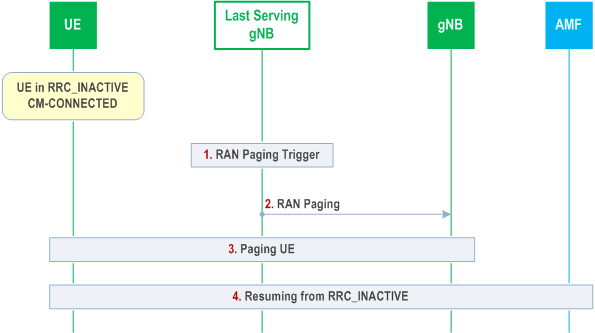Content for TS 38.300 Word version: 18.2.0
1…
4…
4.7…
5…
5.3…
5.4…
6…
6.2…
6.6…
7…
8…
9…
9.2.2…
9.2.2.5…
9.2.3…
9.2.3.2…
9.2.3.3…
9.2.4…
9.2.6…
9.3…
10…
11…
15…
15.5…
16…
16.2…
16.3…
16.4…
16.8…
16.9…
16.10…
16.12…
16.12.5…
16.12.6…
16.12.6.3
16.12.7
16.13…
16.14…
16.15…
16.18…
16.19…
16.21…
16.21.3…
17…
18…
19
20…
21…
A…
B…
C…
G…
9.2.2 Mobility in RRC_INACTIVE
9.2.2.1 Overview
9.2.2.2 Cell Reselection
9.2.2.3 RAN-Based Notification Area
9.2.2.4 State Transitions
9.2.2.4.1 UE triggered transition from RRC_INACTIVE to RRC_CONNECTED
9.2.2.4.2 Network triggered transition from RRC_INACTIVE to RRC_CONNECTED
...
...
9.2.2 Mobility in RRC_INACTIVE p. 79
9.2.2.1 Overview p. 79
RRC_INACTIVE is a state where a UE remains in CM-CONNECTED and can move within an area configured by NG-RAN (the RNA) without notifying NG-RAN. In RRC_INACTIVE, the last serving gNB node keeps the UE context and the UE-associated NG connection with the serving AMF and UPF.
For a UE in RRC_INACTIVE with eDRX cycle longer than 10.24 seconds, the NG-RAN node may, based on implementation, send a request to the AMF to perform MT Communication Handling as described in TS 23.501. If the UE accesses a gNB other than the last serving gNB and upon successful UE context retrieval, the AMF considers that the UE is reachable (i.e., the MT Communicating Handling is deactivated) and triggers the MT DL data/signalling delivery upon receiving the NGAP Path Switch Request message.
If the last serving gNB receives DL data from the UPF or DL UE-associated signalling from the AMF (except the UE Context Release Command message) while the UE is in RRC_INACTIVE, it pages in the cells corresponding to the RNA and may send XnAP RAN Paging to neighbour gNB(s) if the RNA includes cells of neighbour gNB(s).
Upon receiving the RAN Paging Request message from the AMF while the UE is in RRC_INACTIVE with eDRX beyond 10.24 seconds, the last serving gNB may page in its cells comprised in the RNA and may send XnAP RAN Paging to neighbour gNB(s) if the RNA includes cells of neighbour gNB(s), in order to trigger the UE to resume connection in RRC_CONNECTED state, or in RRC_INACTIVE state for DL SDT, based on the DL data size if included in the NGAP RAN Paging Request message.
Upon receiving the UE Context Release Command message while the UE is in RRC_INACTIVE, the last serving gNB may page in the cells corresponding to the RNA and may send XnAP RAN Paging to neighbour gNB(s) if the RNA includes cells of neighbour gNB(s), in order to release UE explicitly.
Upon receiving the NG RESET message while the UE is in RRC_INACTIVE, the last serving gNB may page involved UEs in the cells corresponding to the RNA and may send XnAP RAN Paging to neighbour gNB(s) if the RNA includes cells of neighbour gNB(s) in order to explicitly release involved UEs.
Upon RAN paging failure, the gNB behaves according to TS 23.501.
The AMF provides to the NG-RAN node the Core Network Assistance Information to assist the NG-RAN node's decision whether the UE can be sent to RRC_INACTIVE, and to assist UE configuration and paging in RRC_INACTIVE. The Core Network Assistance Information includes the registration area configured for the UE, the Periodic Registration Update timer, and the UE Identity Index value, and may include the UE specific DRX, an indication if the UE is configured with Mobile Initiated Connection Only (MICO) mode by the AMF, the Expected UE Behaviour, the UE Radio Capability for Paging, the PEI with Paging Subgrouping assistance information, the NR Paging eDRX Information, the Paging Cause Indication for Voice Service, the Hashed UE Identity Index Value and the CN support indication for MT Communication Handling. The UE registration area is taken into account by the NG-RAN node when configuring the RNA. The UE specific DRX and UE Identity Index value are used by the NG-RAN node for RAN paging. The Periodic Registration Update timer is taken into account by the NG-RAN node to configure Periodic RNA Update timer. The NG-RAN node takes into account the Expected UE Behaviour to assist the UE RRC state transition decision. The NG-RAN node may use the UE Radio Capability for Paging during RAN Paging. The NG-RAN node takes into account the PEI with Paging Subgrouping assistance information for subgroup paging in RRC_INACTIVE except when the UE context contains an emergency PDU session in which case the PEI with Paging Subgrouping assistance information shall not be used according to TS 24.501. When sending the XnAP RAN Paging to neighbour NG-RAN node(s), the PEI with Paging Subgrouping assistance information may be included. The NG-RAN node takes into account the NR Paging eDRX Information to configure the RAN Paging when the NR UE is in RRC_INACTIVE. When sending XnAP RAN Paging to neighbour NG-RAN node(s), the NR Paging eDRX Information for RRC_IDLE and for RRC_INACTIVE may be included. The NG-RAN node takes into consideration the Paging Cause Indication for Voice Service to include the Paging Cause in RAN Paging for a UE in RRC_INACTIVE state. When sending XnAP RAN Paging to neighbour NG-RAN node(s), the Paging Cause may be included. When sending XnAP RAN Paging to neighbour NG-RAN node(s), the Hashed UE Identity Index Value may be included to determine the start point of PTW. The NG-RAN takes into account the CN support indication for MT Communication Handling when deciding to request the AMF for MT Communication Handling for a UE in RRC_INACTIVE state with long eDRX beyond 10.24 seconds as described in TS 23.501.
At transition to RRC_INACTIVE the NG-RAN node may configure the UE with a periodic RNA Update timer value. At periodic RNA Update timer expiry without notification from the UE, the gNB behaves as specified in TS 23.501.
If the UE accesses a gNB other than the last serving gNB, the receiving gNB triggers the XnAP Retrieve UE Context procedure to get the UE context from the last serving gNB and may also trigger an Xn-U Address Indication procedure including tunnel information for potential recovery of data from the last serving gNB. Upon successful UE context retrieval, the receiving gNB shall perform the slice-aware admission control in case of receiving slice information and becomes the serving gNB and it further triggers the NGAP Path Switch Request and applicable RRC procedures. After the path switch procedure, the serving gNB triggers release of the UE context at the last serving gNB by means of the XnAP UE Context Release procedure.
In case the UE is not reachable at the last serving gNB, the gNB shall fail any AMF initiated UE-associated class 1 procedure which allows the signalling of unsuccessful operation in the respective response message. It may trigger the NAS Non Delivery Indication procedure to report the non-delivery of any non PDU Session related NAS PDU received from the AMF as specified in TS 38.413.
If the UE accesses a gNB other than the last serving gNB and the receiving gNB does not find a valid UE Context, the receiving gNB can perform establishment of a new RRC connection instead of resumption of the previous RRC connection. UE context retrieval will also fail and hence a new RRC connection needs to be established if the serving AMF changes.
A UE in the RRC_INACTIVE state is required to initiate RNA update procedure when it moves out of the configured RNA. When receiving RNA update request from the UE, the receiving gNB triggers the XnAP Retrieve UE Context procedure to get the UE context from the last serving gNB and may decide to send the UE back to RRC_INACTIVE state, move the UE into RRC_CONNECTED state, or send the UE to RRC_IDLE. In case of periodic RNA update, if the last serving gNB decides not to relocate the UE context, it fails the Retrieve UE Context procedure and sends the UE back to RRC_INACTIVE, or to RRC_IDLE directly by an encapsulated RRCRelease message.
9.2.2.2 Cell Reselection p. 80
A UE in RRC_INACTIVE performs cell reselection. The principles of the procedure are as for the RRC_IDLE state (see clause 9.2.1.2).
9.2.2.3 RAN-Based Notification Area p. 80
A UE in the RRC_INACTIVE state can be configured by the last serving NG-RAN node with an RNA, where:
- the RNA can cover a single or multiple cells, and shall be contained within the CN registration area; in this release Xn connectivity should be available within the RNA;
- a RAN-based notification area update (RNAU) is periodically sent by the UE and is also sent when the cell reselection procedure of the UE selects a cell that does not belong to the configured RNA.
-
List of cells:
- A UE is provided an explicit list of cells (one or more) that constitute the RNA.
-
List of RAN areas:
- A UE is provided (at least one) RAN area ID, where a RAN area is a subset of a CN Tracking Area or equal to a CN Tracking Area. A RAN area is specified by one RAN area ID, which consists of a TAC and optionally a RAN area Code;
- A cell broadcasts one or, in case of network sharing with multiple cell ID broadcast, more RAN area IDs in the system information.
9.2.2.4 State Transitions p. 81
9.2.2.4.1 UE triggered transition from RRC_INACTIVE to RRC_CONNECTED p. 81
The following Figure describes the UE triggered transition from RRC_INACTIVE to RRC_CONNECTED in case of UE context retrieval success:

Step 1.
After step 1 above, when the gNB decides to use a single RRC message to reject the Resume Request right away and keep the UE in RRC_INACTIVE without any reconfiguration (e.g. as described in the two examples below), or when the gNB decides to setup a new RRC connection, SRB0 (without security) is used. Conversely, when the gNB decides to reconfigure the UE (e.g. with a new DRX cycle or RNA) or when the gNB decides to push the UE to RRC_IDLE, SRB1 (with integrity protection and ciphering as previously configured for that SRB) shall be used.
The following Figure describes the UE triggered transition from RRC_INACTIVE to RRC_CONNECTED in case of UE context retrieval failure:
The UE resumes from RRC_INACTIVE, providing the I-RNTI, allocated by the last serving gNB.
Step 2.
The gNB, if able to resolve the gNB identity contained in the I-RNTI, requests the last serving gNB to provide UE Context data.
Step 3.
The last serving gNB provides UE context data.
Step 4/5.
The gNB and UE completes the resumption of the RRC connection.
Step 6.
If loss of DL user data buffered in the last serving gNB shall be prevented, the gNB provides forwarding addresses.
Step 7/8.
The gNB performs path switch.
Step 9.
The gNB triggers the release of the UE resources at the last serving gNB.

Step 1.
The following Figure describes the rejection form the network when the UE attempts to resume a connection from RRC_INACTIVE:
The UE resumes from RRC_INACTIVE, providing the I-RNTI, allocated by the last serving gNB.
Step 2.
The gNB, if able to resolve the gNB identity contained in the I-RNTI, requests the last serving gNB to provide UE Context data.
Step 3.
The last serving gNB cannot retrieve or verify the UE context data.
Step 4.
The last serving gNB indicates the failure to the gNB.
Step 5.
The gNB performs a fallback to establish a new RRC connection by sending RRCSetup.
Step 6.
A new connection is setup as described in clause 9.2.1.3.

9.2.2.4.2 Network triggered transition from RRC_INACTIVE to RRC_CONNECTED p. 83
The following Figure describes the network triggered transition from RRC_INACTIVE to RRC_CONNECTED:

Step 1.
A RAN paging trigger event occurs (incoming DL user plane, DL signalling from 5GC, etc.).
Step 2.
RAN paging is triggered; either only in the cells controlled by the last serving gNB or also by means of Xn RAN Paging in cells controlled by other gNBs, configured to the UE in the RAN-based Notification Area (RNA).
Step 3.
The UE is paged with the I-RNTI.
Step 4.
If the UE has been successfully reached, it attempts to resume from RRC_INACTIVE, as described in clause 9.2.2.4.1.